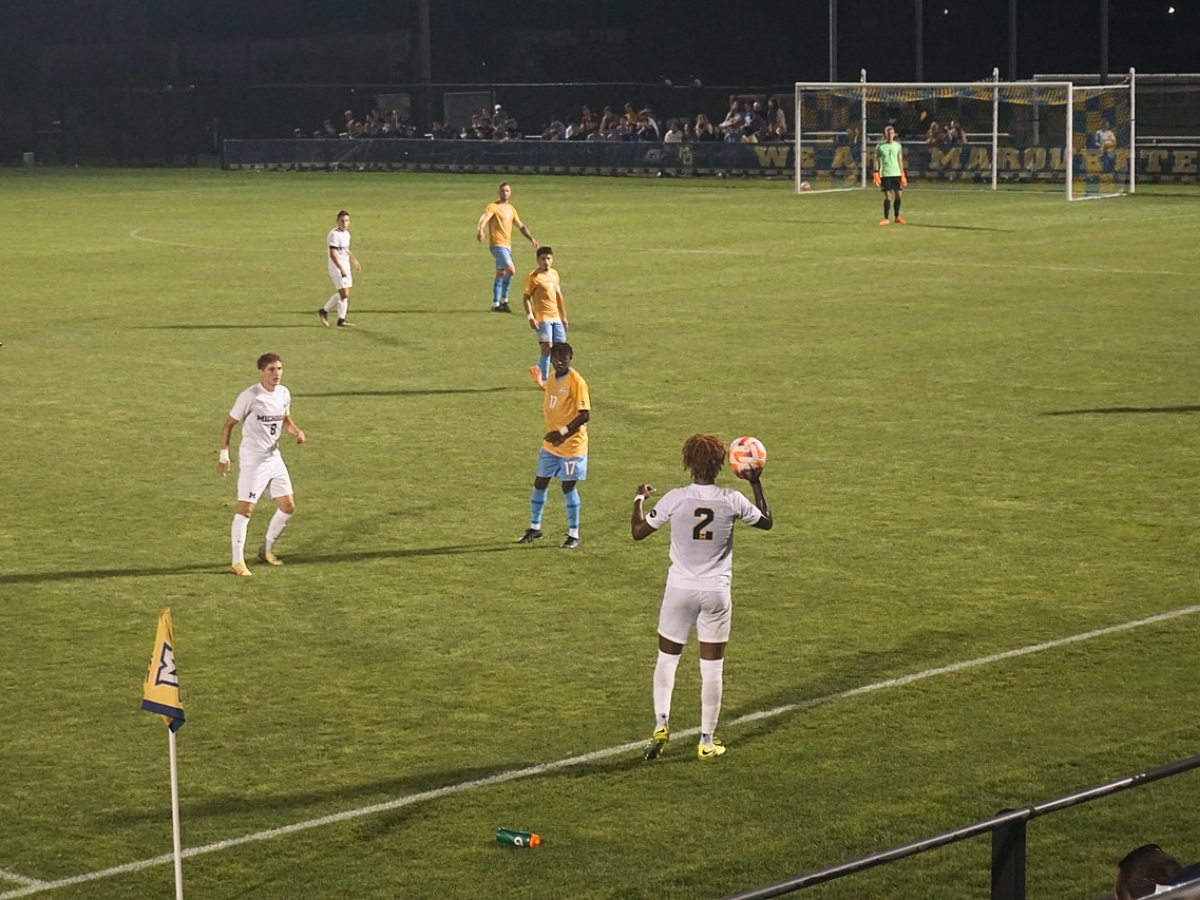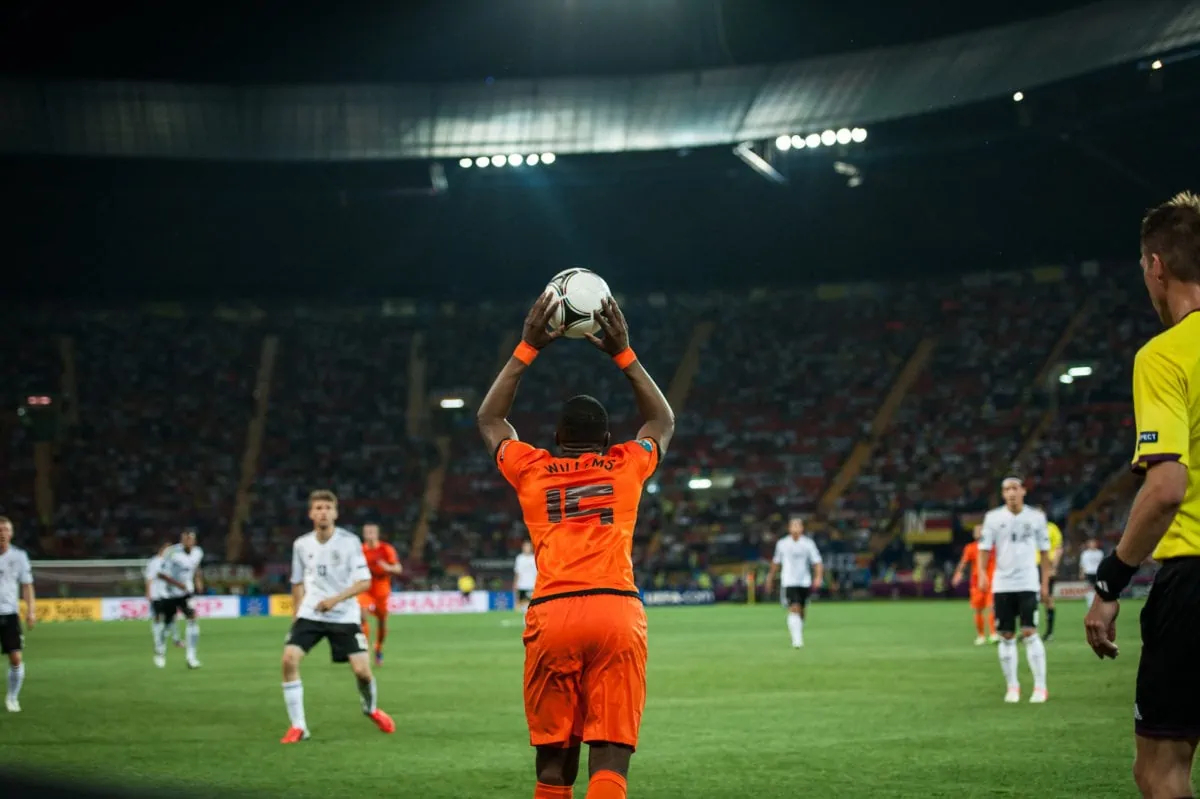Share the post "Throw Ins in Soccer: Technique, Rules, and Strategic Play"
Throw-ins are crucial to soccer but are often disregarded for strategy. I usually find that a well-executed throw-in may swing the game, allowing teams to rapidly switch from defense to attack or keep possession in vital moments. Every player must know the throw-in regulations and technique to restart play when the ball goes out on the sidelines.
Soccer’s laws specify throw-in execution. You need both feet on the ground and behind the touchline, both hands to toss the ball from behind and over the head, and the ball to enter the field. These regulations apply to all players, from youth to professionals, to guarantee the throw is legal and useful to their side.
When examining tactics, throw-ins are more fascinating. They can surprise opponents and create scoring chances. Throw-ins can turn seemingly unthreatening circumstances into assists or shots on goal by targeting teammates in strategic positions and exploiting opposing formation gaps. Thus, understanding throw-ins is about seeing their potential in a game, not just following regulations.

Basics of Throw Ins
In soccer, throw ins are a fundamental way to resume play from the sidelines. Here’s the scoop on their purpose and the rules governing them.
Watch our videos on throw-in:
Definition and Purpose
Throw ins occur when the ball completely crosses the sideline, known as the touchline, and the game needs to be restarted. I use a throw in to put the ball back into play, giving my team a chance to maintain or regain possession in strategically advantageous ways.
The Rules of Throw Ins
There are clear instructions I follow when taking a throw in:
- Positioning: My feet must either be on or behind the touchline; one part of each foot should be either on the line or on the ground outside the line.
- Ball Handling: I must hold the ball with both hands, gripping it from behind and over my head.
- Execution: The throw must be delivered from behind and over my head, ensuring the ball enters the field of play.
Failing to adhere to these rules results in the throw in being given to the opposing team. It’s vital for me to follow these steps precisely to avoid a turnover and to maintain the advantage for my team.
Executing a Proper Throw In
In taking a throw-in, my goal is to reintroduce the ball into play while looking to retain possession of the ball. Here’s how I ensure my technique is correct and avoid common pitfalls.
Correct Technique
To perform a legal throw-in, I follow these specific steps:
- Position: I ensure that my feet are either behind or on the touchline. This means my toes can be on the line, but not over it.
- Grip: I hold the ball with both hands, fingers spread for control so I can throw it long if needred.
- Delivery: Starting from behind my head, I bring the ball forward over my head and release it when my hands are above my head.
- Stance: Both feet must stay on the ground, either on or behind the touchline, until the ball is released. For a short throw I have my legs side by side and for a long throw my strongest foot is forward and I take a short run-up.
- Direction: First I try look for a player who is free or is looking to make a run. So retaining possession or starting an attack are the main objectives. Otherwise, if my teammates are marked and there is no space, I throw to the strongest players to get a hold of the ball.
Common Mistakes and How to Avoid Them
Mistake: Stepping over the line before the ball is thrown.
Correction: I practice my stance to keep my feet in the correct position until after the ball has left my hands.
Mistake: Throwing the ball from the side of the head or with one hand.
Correction: I ensure that every practice throw starts behind my head and that I use both hands equally to push the ball over my head.
By concentrating on these aspects, my throw-ins are both accurate and within the guidelines set by soccer authorities.
Strategies in Play
In soccer, effectively using throw-ins can shift the dynamics of the game. I’ll discuss the nuances of short versus long throw-ins, specific set plays, and key positioning tactics.
Short vs. Long Throw Ins
Short Throw-Ins are akin to a quick pass, keeping the game’s tempo and retaining possession. They allow players to:
- Maintain control in tight spaces
- Quickly restart play
- Connect with nearby teammates
Conversely, Long Throw-Ins can serve as offensive weapons, almost like corner kicks, by:
- Reaching players in the attacking third
- Creating goal-scoring opportunities
- Surprising the defense when executed fast
Throw In Set Plays
Throw In Set Plays remind me of choreographed sequences aimed at catching the opposition off-guard. These include:
- Designated runs
- Picks to free up a teammate
- Specific areas targeted for ball delivery
The right set play can peel open a defense or sustain an attack.
Positioning and Movement
Mastering Positioning and Movement during a throw-in ensures maximum advantage. I focus on:
- Body angles to receive the ball
- Creating spaces by drawing defenders away
- Coordinated movement to provide throw-in options
Awareness of teammates’ positions is critical to exploit spaces and maintain possession.

Defensive Tactics
In soccer, solid defensive tactics during throw-ins are crucial to maintaining control of the game. I focus on two main strategies: applying pressure through marking and anticipating the ball’s trajectory to intercept the throw.
Marking and Pressure
When the opposing team is taking a throw-in, I make sure to mark each player tightly. Proper marking involves:
- Staying Close: I keep myself an arm’s length away from the player I’m marking to prevent them from receiving the ball easily.
- Body Positioning: My body is positioned between the opponent and the goal, which makes it difficult for them to turn towards goal if they receive the ball.
- Communication: I constantly communicate with my teammates, ensuring that every opponent is covered and there’s no room for a quick advantage.
Intercepting the Throw
My goal during a throw-in is also to foresee where the ball will go and cut off that pass. To intercept a throw, here’s what I concentrate on:
- Reading the Thrower: I watch the thrower’s body language and arm movements to predict the throw’s direction.
- Anticipation: I position myself in likely ball paths, ready to move quickly to intercept.
- Reactivity: Once the ball is in play, I rely on my reflexes and speed to beat the intended receiver to the ball.
Training for Throw Ins
I’ll focus on enhancing two critical skills for soccer throw ins: technique and strength. With proper drills and exercises, you can improve your throw ins, making them a valuable part of your team’s tactical arsenal.
Drills and Exercises
To get the mechanics of a throw in right, I recommend starting with the basics. Here’s a simple drill I use:
- Footwork & Balance Drill:
- Stand along the touchline with a ball.
- Practice the throw in motion while keeping both feet planted on the ground.
- Progress to lifting your heels slightly off the ground as you throw, ensuring your toes stay in contact with the ground.
Repeat this drill multiple times to build muscle memory for the correct foot positioning.
- Two-Player Drill:
- Work with a partner, standing 5-10 yards apart.
- Take turns performing throw ins to each other.
- Focus on consistent grip and a fluid motion over the head.
- Increase the yards as you perform perfect throw.
This drill helps simulate game conditions and ensures your throw ins are accurate under pressure.
Improving Accuracy and Power
To boost the accuracy and power behind my throw ins, here’s what I work on:
- Target Practice:
- Set up cones or targets at various distances.
- Practice throwing the ball to hit the targets.
- Start close, gradually increasing the distance as your accuracy improves.
- Strength Training:
- Upper Body Workouts:
- Perform exercises such as push-ups, pull-ups, and shoulder presses.
- Core Exercises:
- Incorporate planks and medicine ball throws to build a strong core, which is essential for a powerful throw.
- Upper Body Workouts:
By including these exercises in my training regimen, I’ve noticed a significant increase in the power and accuracy of my throw ins.
Throw Ins in Different Levels of Play
In my experience, the specifics of throw-ins can vary quite a bit between different levels of play, and understanding these nuances is crucial for players and fans alike.
Youth and Amateur Soccer
In youth and amateur soccer, throw-ins serve as a fundamental aspect of soccer education. Here, I’ve noticed that an emphasis is often placed on players learning the correct technique. This includes standing behind the touchline, keeping both feet on the ground, and delivering the ball with both hands from behind and over the head. Mistakes are common at these levels, but they are also instructive moments since referees tend to be more lenient, often allowing players to retake an incorrect throw-in.
- Key Points:
- Emphasis on learning proper technique
- Greater leniency for mistakes
Professional and International Games
At the professional and international levels, throw-ins become a strategic tool. Precision and tactical execution are quintessential. Players like Rory Delap, notable for his long throw-in ability, have shown that throw-ins can be as dangerous as corner kicks in the right hands. Teams often have set plays designed for throw-ins to exploit defensive weaknesses. Referees in professional games enforce rules more strictly, and infractions can lead to a turnover in possession.
- Key Points:
- Throw-ins used strategically
- Strict rule enforcement
Historical and Notable Throw Ins
In my research on soccer, I’ve noted that the throw-in has interesting historical developments. Initially, players could throw the ball in any direction, but since 1863, throw-ins had to be thrown in from where the ball left the field and only in the direction your team was attacking. This rule was part of the original Laws of the Game established by the English Football Association.
During the late 19th century, there were no restrictions on the throw-in technique, allowing for tactics that seem bizarre by today’s standards. Some players would perform a somersault while throwing the ball to gain more distance. Imagining that in a modern game brings a smile to my face!
One particularly notable throw-in technique is termed the ‘flip-throw’. A player runs up, flips forward, and releases the ball at the apex of the flip to gain extra power and distance. I’ve watched players like Rory Delap of Stoke City turn this tactic into an almost corner-like offensive opportunity, creating chaos in the opponent’s penalty area.
Table: Evolution of Throw-in Rules
| Year | Rule Change |
|---|---|
| 1863 | Throw-ins reintroduced in any direction. |
| 1872 | Throw-ins had to be done with two hands, overhead. |
| 1881 | The ball was required to be thrown at right angles to the touchline. |
| 1938 | Players were required to face the field of play during a throw-in. |
These days, while the basic throw-in remains a utility to restart play, some teams integrate them into their strategic planning, turning them into an unexpected weapon. It’s a testament to soccer’s enduring capacity for creativity and innovation.
Share the post "Throw Ins in Soccer: Technique, Rules, and Strategic Play"
Joel is a seasoned soccer journalist and analyst with many years of experience in the field. Joel specializes in game analysis, player profiles, transfer news, and has a keen eye for the tactical nuances of the game. He played at various levels in the game and coached teams - he is happy to share his insight with you.



